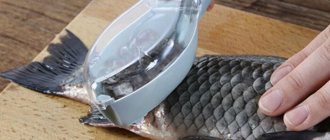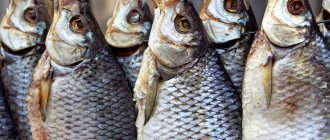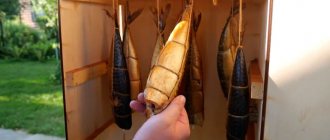And now you have pleased yourself and your loved ones with a luxurious catch. But it is important not only to catch fish, but also to process it - either cook it or put it in a condition suitable for long-term storage. Fortunately, with the advent of freezers, the problem of storing catch has practically been solved, but their capacity is not infinite. And sometimes you want to try something spicy! Therefore, we have not stopped drying fish and happily consuming it in this form.
Well-cured fish is a real delicacy, especially appreciated by lovers of savory dishes. Moreover, many children who cannot stand it fried or boiled enjoy eating dried dietary meat. And today we will tell you how to cook dried fish quickly, efficiently and with pleasure, so that it retains maximum beneficial properties!
Spicy pickling
To work you need to prepare:
- Tara. This can be a deep bowl or basin, an enamel bucket, or a wooden box. You can also take a plastic container. But you can't use anything metallic.
- Spices. Black pepper and laurel must be included.
- Table salt. Preferably not very fine, and in no case iodized.
- Cargo. They can serve as a not very heavy stone, a couple of bricks wrapped in a plastic bag, a jar or a small enamel pan with water or any other similar item.
- The lid is slightly smaller than the top of the pickling container.
This salting option is designed for perch, bleak and other small fish. The catch must be fresh, preferably just caught. You need to choose specimens of approximately the same size weighing up to 1 kg.
The catch must be washed and gutted. Next, salt (0.5 cm) is first poured onto the bottom of the salting dish and the fish is placed, starting with the larger specimens. Having laid the first layer, sprinkle a thin layer of salt on top, add several leaves of laurel, 2-3 grains of pepper, and coriander. Then again fish, salt with spices and so on until the top, or until the fish runs out.
Attention! The time has come to apply pressure to force out all the air from the fish - the cause of putrefactive reactions. To do this, you need to take the lid, place it on the fish, and put a “salting” weight on top.
Now you need to move all this stuff to the coolest place in the house (or apartment) for 72-96 hours. After finishing the salting process, remove the lid and rinse the fish under running water so that all the salt is washed off. When the water becomes clear, leave the pan like that for 60-90 minutes.
Some fishermen claim that it is necessary to keep the fish in the water for every 24 hours of salting - 1 hour. For example, if the fish were in salt for a day, then soak for 1 hour, if for 2 days - 2 hours, and so on. Then drain the water, cover the table with newspapers in several layers and place the fish on top to dry.
After 3-4 hours it will become dry, which means it will be ready for use. Such a treat has an excellent taste and excellent smell. You can eat it with beer, mashed potatoes and porridge - it makes a universal snack. Spicy salted fish can be stored for a long time, but only in the refrigerator. However, it usually doesn’t sit around for long.
Practical useful tips
When processing and storing their catch, experienced fishermen pay attention to details to make the process easier and more efficient:
- When salting, large specimens are placed on the bottom of the dish, and small ones on top.
- Carcasses of the same size are strung on one cord. Then it will be ready at the same time.
- To make drying at home faster, the bellies are opened by inserting toothpicks.
- In winter, they make a frame box for hanging. Together with the frame, the fish can be moved from place to place.
- From large, fatty specimens, balyk can be prepared by drying.
- If fish becomes damp and has a musty taste if stored improperly, it can be washed in a weak salt solution and dried again.
Drying fish is a simple and effective process. Over time, experience is gained that allows you to make the most of existing conditions and opportunities. You need to carefully monitor how the properties of fish change during drying. Then you will get a tasty and aromatic delicacy that can be served both at the holiday table and consumed at a warm friendly meeting.
In this video, an avid fisherman shares tips on how to properly dry fish.
Dry pickling
Usually roach, gobies, and perch are prepared this way. They must be prepared in the same way as in the previous recipe - washed, gutted and salted, placing them in layers in the selected container. There is no need to use spices, but some people still add sugar or their favorite spices. After two, maximum three days, the fish carcasses are washed, wiped dry with cloth napkins and hung by the eyes or tail on a rope.
You need to hang it tightly, but in such a way that air passes between the individual carcasses. Moreover, place the product not in the sun, but in the shade. For example, on a balcony or in a room where there is a constant draft. This way the catch will dry better and will not become damp later.
If the process occurs in the spring, when there are no flies, then you don’t need to do anything, just wait until the product is ready, but in the summer, the catch hung out for drying must be wrapped in gauze, folded in 3-5 layers, so that the flies do not get to it. If you don’t do this, then maggots will quickly appear in the fish, and it will be unsuitable for consumption. How long to dry the carcasses depends on the taste of the owners. Some people keep it like this for several days, others for half a day.
If you come across a large roach, perch, or goby (which, although rare, does happen), then it needs to be gutted and freed from the head. Then make several cuts along the back from the head to the tail and rub salt into them. Possibly with spices. After sprinkling the entire catch with salt, leave it for 8-10 days in a cool room. The brine that appears must be drained every day. After washing, when hanging out to dry, each individual is inserted into the abdomen with a wooden spacer (for example, toothpicks or twigs peeled from bark).
If the whole process is carried out correctly, then the carcass will be similar in appearance to balyk, which is why this version of salting is popularly called “balykov”. The taste of the resulting product is very refined.
Small fish, such as roach, are even easier to salt since they do not need to be gutted. It is washed, salted, layered, and the container is placed in the refrigerator for 3, maximum 5 days. Then the product is washed and kept in clean water for an hour. After this, dry on paper towels and hang the carcasses on a thread or skewer. The catch is dried for 5 to 10 days - it all depends on the size of the roach and the air temperature outside or in the room where the product is dried.
Using household appliances
If it is not possible to dry fish using any of the methods described, you can use household appliances. This is suitable for small fish.
You need to follow these instructions:
- Allow the carcass to drain after soaking for a sufficient amount of time.
- A baking sheet from the oven should be covered with thick parchment paper and the carcasses should be placed on it in one layer.
- Set the oven temperature to 40-50 degrees and convection mode, place a baking sheet there. You can open the door a little so that moisture comes out and the drying process is more efficient.
- After a few hours, depending on the size of the fish, you need to turn the carcasses over and let them sit for about the same amount of time.
- After removal, the carcass should be strung on a wire and kept for ripening in natural conditions.
Yandex pictures
Another option for using household appliances is drying in electric dryers. Models that have such a function in the menu are especially good.
Wet Ambassador
The process goes like this:
- The fish should be placed belly up. Add salt. For 1 kg of catch - 100 g of salt. To make the taste more delicate, you can add sugar - 0.5 tsp.
- Place a lid on top, a circle that fits under the pickling container. You can make a circle from linden or aspen.
- Place the container in a cool room for 4-8 days. Do not touch the prominent brine.
- Remove the fish from the liquid and rinse. Dry outdoors.
- Store in a basket. You can use a wooden box.
If the fish is small, it can be immersed in brine for salting. It is prepared from 3 liters of water and 1 kg of salt. Next, rinse, dry and store.
Storage of the finished product
Only a refrigerator and freezer can provide the longest storage of dried and dried fish. Before storing the fish, you need to wrap it well in newspapers or parchment paper, and then in a plastic bag or film.
Sealing is very important. If this is not followed, all neighboring products will quickly smell like fish.
Important! You can store fish in the refrigerator in glass jars or plastic containers with lids.
Yandex pictures
Dried fish has a shorter shelf life at room temperature. To do this, you also need to wrap it in paper, put it in a wooden box with a lid or a plastic container. The container should be placed in a cool, protected from the sun room.
Sagging Ambassador
Used for fatty fish. Large representatives of fish are prepared and hung on rods. Then they are placed in a saline solution. The brine should be so salty that the raw potatoes float. The carcasses need to be placed so that they are not too squeezed against each other. After a week, the product can be removed from the brine and, after washing and drying, eaten.
If you catch a big catch in the summer heat far from home, you can do the following:
- Salt the fish carcasses in a large plastic bag.
- Bury the bag in the soil (it doesn’t matter whether it’s sand or earth). The burial depth is 0.7-1 m. The soil layer will serve as protection from heat and at the same time as oppression.
- To prevent moisture from dew or rain from penetrating inside the bag, you need to put a small bag over the neck.
If the fish carcasses are large in size, then they must first be gutted, wiped dry (no washing!), and cut off the head and tail. Rub the outside of each carcass. Sprinkle salt into all cuts and inside. Wrap in clean burlap. You can also use a cloth napkin. Wrap tightly with twine or bandage. Before cooking, the carcasses are soaked using milk or water. Then they cook - boil, stew, fry. The choice of option is to your taste. You can also eat it raw, seasoned like a herring.
Advice. If you catch a large catch in winter and freeze thoroughly on the way home, you should not salt such fish: after defrosting, the tissue structure is already damaged, so it picks up a lot of salt. Because of this, it is very difficult to catch the moment when the carcasses are salted and the fish can be significantly over-salted. In addition, when soaking and hanging, carcasses may disintegrate. It is best to process the catch that has survived freezing and thawing into stew.
Dried or dried fish: what's the difference?
Few can give the correct answer to the question of how dried fish differs from dried fish.
In this case, in any case, the fish is salted and necessarily soaked. The drying process takes place in well-ventilated areas with access to sunlight. The drying process in this case is accompanied by complex physical and biochemical processes. In addition, dried fish is not a semi-finished product and can be eaten immediately without subjecting it to additional processing.
On a note!
There are special dryers for drying fish, but in a pinch, a balcony will do.
As for dried fish, it is considered a semi-finished product and its consumption requires additional processing. All this is due to the fact that fish does not ripen during this process due to the nature of the process itself.
Although there are many ways to salt fish, you can only use one of the presented ones. Withering or drying fish at home is not difficult, just take water and salt. This is the simplest, classic method that does not require much time. In addition, a small fish does not require much preparation time. It is better to additionally steam salted fish (dried) before serving. As a side dish, boiled potatoes are suitable, which go well with any salted fish.
Drying fish: stages and secrets
So, let's look at the most important stages of selecting and drying fish:
- First you need to decide on the fish itself and its size. Capelin, perch, roach, carp, ram, pike perch, salmon, etc. are suitable.
- The size and weight of the fish is very important. You cannot use very large fish, so it is better to put carp weighing 10 kg aside. Small fish are also not suitable for salting. Ideally, the weight should not exceed 1 kg.
- You should choose fish that is not too fatty, otherwise you will have to add a large amount of salt, which may affect the taste of the finished product.
- When we have decided on the choice of fish, we should move on to cleaning it. It needs to be gutted and thoroughly cleaned from the inside. The scales should be left, but all the insides should be carefully removed. The intestines and mucus will taste bitter, although some prefer this.
- Coarse salt should be used, as it draws out water best.
Salting fish and hanging methods
The salting method itself is simple:
- We take a pan or bowl suitable for our fish. Sprinkle a thin layer of salt and spread the product. We repeat the procedure several times until we have laid out all the fish.
- Salt should cover the fish, but do not overdo it
- Now the fish should be left under pressure. If you use an insufficient amount of salt, the product may be poorly salted or even rot, while an excessive amount will make the fish too salty and impossible to eat. Some people like to add various spices such as pepper, bay leaf, a little sugar and other ingredients to taste. If this is your first experience in this matter, then it is better to use a simpler option with salt
- A few days later, when the fish is sufficiently salted under pressure, it needs to be washed and cleaned well before drying. To do this, you need to prepare 3% vinegar or sunflower oil. This is necessary so that larvae do not appear in the fish if the flies do get to your treasure. Simply dip it into the solution once
- It is worth washing the fish very well. At this moment, all unnecessary residues - mucus, giblets - should come out of the product. Also at this stage all excess salt is removed.
- The drying itself will last quite a long time and can take 7-8 days. If you try the drying method over the stove, the time is halved
- The product should be hung in the late afternoon, outdoors in the shade or in a room that is sufficiently ventilated. To prevent your fish from being attacked by flies, you can wrap it in gauze
It’s worth saying a few words about hanging methods.
- If you hang it by the tail, drying will be more uniform, and excess fat will be removed. This method will allow dried fish to be stored much longer.
- Fans of “beer with fish” are more likely to show you this option - drying fish suspended through the eye. In their opinion, this way the fish retains the correct taste and aroma
Dried fish is really very tasty. As you can see, the process of salting this product, and in principle its drying, is completely simple. The main thing is desire and a little patience - in this case, in just a few weeks you will be able to enjoy this incredible delicacy!
sovetclub.ru
For drying, choose not very large fish up to half a kilogram. In the hot season it is necessary to gut it, in the cold season - not. There is no need to wash the fish, just wipe with a dry towel to remove excess moisture. For cooking, be sure to use coarse salt. Any other method will not work, since our goal is not to add flavor to the fish, but to remove moisture from it. Such fish, salted for drying, will have an excellent smell and taste. The only downside of coarse salt is that it dissolves slowly, but absorbs more moisture.
Next, we do this: pour salt into a bucket or basin (if you don’t have either, you can take a pan), but not too much. The fish should be laid out so that the head of one touches the tail of the other. Salt each layer well.
After the fish is finished, you need to pour enough salt on it so that it covers the entire surface. You can add a little sugar for taste. Cover with a lid and place under pressure. The heavier the pressure, the tastier the fish will be. It prevents air from leaking into the container and prevents the growth of bacteria. After about 5 hours, the fish releases its juice - brine. It needs to be kept in as cool a place as possible, maybe even on ice.
How much salt should I salt fish for drying or drying? It takes about two to three days to salt in this way. After this time, the meat of well-salted fish becomes gray. The next stage will be preparation for stringing and hanging. Salted fish should be soaked under running water until it begins to float.
The fish is hung in the following way: special hooks are passed through the eye and hung on a rope. The fish must dry after soaking, so it is better to hang it out overnight to prevent flies from sitting on your catch. In the morning, to repel flies, the fish are sprayed with a solution of vinegar and water. Drying or drying lasts up to eight days, it all depends on the size of the fish.
www.safetymoscow.ru
Selection and preparation of carcasses
This process works best in the spring (before spawning) and autumn. Firstly, at this time the fish accumulates sufficient reserves of fat, so the meat acquires the best taste. In summer, especially in the first half, representatives of the freshwater ichthyofauna are still recovering from the breeding season, and their meat is a bit tough and not as tasty as we would like.
However, this does not mean that fish dried in summer is not suitable for food at all: it is quite possible to eat it, even with great pleasure. The problem is different: during the warm period, the number of insects goes off scale, wanting to feast on a potential delicacy or use it to reproduce their own kind. Therefore, the issue of protecting drying carcasses from persistent attacks of wasps and flies comes to the fore.
There are no insects in winter, which is good news, but the temperature conditions are far from optimal, and the humidity sometimes goes off scale. During this period, it is recommended to move the process to the balcony (if you have a glazed one) or use artificial heat sources.
In general, the process can be carried out year-round, simply by modifying its conditions. In this case, you can take absolutely any fish. Roach and its subspecies (ram and roach), silver bream, bleak, bream and so on are optimal. Perch, pike perch and pike are somewhat dry, but there are also lovers of the tough meat of the predator. Flat-bodied fish dry best, so it makes sense to cook tench or carp in a different way.
It is necessary to select fresh, undamaged carcasses that have retained the integrity of their scales. The slightest odor or other signs of decomposition will negatively affect the quality of the final product.
Before salting, carcasses must be thoroughly rinsed in running water, paying special attention to the gill slits. To gut the fish or not is a matter of taste and season. There are a few things to consider:
- During the summer, peaceful fish eat a decent amount of algae, so if you do not remove the intestines, which are clogged with all this “good,” the meat will acquire an unwanted bitterness. And in the stomach of a predator you can also find undigested prey - not a very appetizing find when cutting up a dry carcass at the table.
- Large fish with entrails are not dried well using artisanal methods, so it is necessary to remove them. If desired, you can leave the caviar and swim bladder inside. Making cuts along the spine will also help: you will have to pour separate portions of salt into the belly, the above-mentioned cuts and gill slits.
- In autumn and spring, it is better to dry small fish with giblets: this will give the taste of the meat additional piquancy.
Primary requirements
Before drying or drying fish, you need to decide how salty it should be.
Now we’ll talk about how much to salt fish for drying, and you can make this delight yourself at home or in the country. If the fish contains ten percent salt, then it is considered lightly salted; if it contains twenty percent or more, it is considered highly salted. The brine (the juice that the fish secretes, mixed with salt) is periodically drained to prevent bacteria from multiplying and spoiling the fish. Fish for drying or drying must be fresh and chilled. Only after this can you start gutting. Salting fish for drying is a very responsible matter. It is necessary to gut the insides so that microbes do not get on the meat.
Salting small fish
For salting small fish, a barrel or an enamel pan is considered ideal. In order to salt fish for drying, you need to wash it and rub it with a special mixture of saltpeter and salt. The proportions for such a mixture are 10:1. Saltpeter is an excellent preservative. It prevents products from spoiling and gives them a beautiful reddish tint. Place layers on the bottom of a barrel or pan: fish - mixture, cover with a lid and place under pressure. The container must be kept in a cool place. If you suddenly don’t have saltpeter, then the recipe for salting fish for drying becomes a little more complicated. In this case, you will have to gut the fish and remove the gills. You can add various spices to the pickling to taste: currant leaves, blackberries, bay leaves, cloves, black pepper, allspice, cumin and even rosemary. It all depends on your preferences. After salting, the fish can be dried, or you can eat it just like that, washing it with water and sprinkling it with sunflower oil.
How to properly prepare fish for salting
There are two types of carcass preparation.
- For big fish. If the carcass is more than 30 cm in length, then it must be gutted. To do this, it is washed, the abdomen is ripped open and the entrails are removed. Then wash everything again in cool water. It is not recommended to cut off the head, but the gills must be removed.
- For small fish. Small carcasses up to 30 cm practically do not need to be prepared. They can be salted ungutted. The only requirement is that the gills must be removed.
How to salt fish for drying or wet drying
For drying, choose not very large fish up to half a kilogram. In the hot season it is necessary to gut it, in the cold season - not. There is no need to wash the fish, just wipe with a dry towel to remove excess moisture. For cooking, be sure to use coarse salt. Any other method will not work, since our goal is not to add flavor to the fish, but to remove moisture from it. Such fish, salted for drying, will have an excellent smell and taste. The only downside of coarse salt is that it dissolves slowly, but absorbs more moisture.
Next, we do this: pour salt into a bucket or basin (if you don’t have either, you can take a pan), but not too much. The fish should be laid out so that the head of one touches the tail of the other. Salt each layer well. After the fish is finished, you need to pour enough salt on it so that it covers the entire surface. You can add a little sugar for taste. Cover with a lid and place under pressure. The heavier the pressure, the tastier the fish will be. It prevents air from leaking into the container and prevents the growth of bacteria. After about 5 hours, the fish releases its juice - brine. It needs to be kept in as cool a place as possible, maybe even on ice.
How much salt should I salt fish for drying or drying? It takes about two to three days to salt in this way. After this time, the meat of well-salted fish becomes gray. The next stage will be preparation for stringing and hanging. Salted fish should be soaked under running water until it begins to float. The fish is hung in the following way: special hooks are passed through the eye and hung on a rope. The fish must dry after soaking, so it is better to hang it out overnight to prevent flies from sitting on your catch. In the morning, to repel flies, the fish are sprayed with a solution of vinegar and water. Drying or drying lasts up to eight days, it all depends on the size of the fish.
Concept of the drying process
Drying any product involves getting rid of excess moisture in one way or another. The same applies to drying fish: moisture is removed from the carcasses, the meat becomes denser, acquiring a piquant aroma. At the same time, fish oil and other nutrients are preserved in the pulp, so this delicacy can be called a storehouse of useful microelements.
This bait provides a rich catch even with a bad bite!
Read more Unfortunately, the excess salt formed during salting somewhat neutralizes the beneficial properties of this product, so you need to thoroughly soak the carcasses before drying. There are technologies that allow you to dry fish without salting, but in our conditions they are of little use. As a rule, this option is used by northern peoples, where climatic conditions allow carcasses to be rid of residual moisture during dry frost and wind.
Theoretically, it is possible to dry salt-free fish in an oven or a special dryer, but does this make sense? Such a semi-finished product requires subsequent soaking and cooking, that is, in this case, the goal is only to preserve a large catch for the purpose of its subsequent use in cooking. A freezer is much better suited for these purposes.
People often ask how the drying process differs from drying? Practically nothing, just drying is a production process, and drying is a handicraft process. In production conditions, it is possible to bring the product to optimal condition while maintaining beneficial properties. If you try, you can achieve a similar result at home. So, let's begin?
Salting fish for drying or dry-drying
How to salt fish for dry drying and which fish is best suited for this? There are answers to these questions. Salting fish for drying or drying in this way is more suitable for large fish. During wet salting, we did not cut up the fish; immediately we need to not only remove the insides, but also divide the fish into two halves and wipe it with a dry towel. The inside needs to be sprinkled well with salt. For this salting, the fish is placed in layers in a box. It is best to take a wooden one - the juice secreted by the fish will flow out through the holes. The box must be placed in a hole. They usually dig it out in the shade and cover it with film so that insects cannot get to the fish. The ambassador lasts up to a week. This method is also suitable for salting small fish. You don't even have to gut it.
Here's what you need to do for this:
1) Take a cutting board and place a clean towel on it.
2) We put the fish in a row like “sprats in a jar”.
3) Sprinkle with salt and wrap in a towel.
4) Cover with another board and put pressure on it.
When salted this way, the juice flows out through the fabric. After the fish has been salted, it is removed from the towel, washed in cold water, soaked for a short time and hung. The best drying method is a wooden box prepared in advance with gauze or mesh walls, but this can also be done in a simple way. We take a “gypsy” or shoe needle, thread a nylon thread or fishing line through it and string the fish, threading the thread through the eye holes. We put gauze or a mosquito net on top of the rope and dry it for seven to ten days. Large fish are best hung at a high height on a pole.
Designs for drying
If you have to dry a small portion of small items, you can do without hanging the carcasses. You need to lay foil on the table or windowsill, and clean paper on it. You need to lay out small change on these layers and cover it on top with light natural fabric or gauze (the last point is relevant in the summer, as it provides protection from flies). The fish will have to be turned over daily, replacing the sodden paper with dry paper as necessary. However, you need to be prepared that the room will smell of fish, and this aroma is not for everyone.
Usually fish is dried using the hanging method. Let's look at the most common options:
- Stretched wire . It is optimal to use stainless steel wire with a small cross-section. Threading is carried out through the eye or gills, maintaining a distance of at least a centimeter between the carcasses. The length of the “garland” is not important: the main thing is that it be possible to stretch it between the supports and securely fasten it. In the summer, protection from flies and wasps in the form of curtain tulle, gauze or light cotton fabric is highly desirable.
- Chalky . In this case, a stiffer wire is used that is capable of holding a given shape. We measure half a meter of wire, bend one end into a loop, string 3-7 fish, form a hook at the free end, fix it on the loop of the other end. Chalks can be hung on nails or hooks, or they can be strung on a crossbar or horizontally stretched wire.
- Frame structures . Frames in the form of parallelepipeds, pyramids, cones, cylinders are made of wood, metal rod, rigid wire, and so on. They are covered with a mosquito net or gauze to protect the drying fish from insects and wind-blown debris. Structures for hanging carcasses are mounted inside: crossbars or hooks for tensioning wire.
Drying fish in nature
Many people wonder how to salt fish for drying outdoors. If you went on a picnic with friends for a couple of days and caught some fish, you can safely dry or wilt it right on the spot. How to salt fish for drying in camp conditions? The gutted catch is placed in a bag of salt for a day, and then hung in the fresh air. You can secure the fish with clothespins, hanging them by their tails in the fresh air. The most acceptable weather for this is windy. To protect against insects, the fish is wrapped in gauze and wiped with sunflower oil or a manganese solution. The optimal drying or drying temperature is up to twenty degrees. In its natural environment, fish is dried for up to two weeks. It is better to store dried fish in a fabric bag in a ventilated place, but please note that after drying it should “simmer” for up to a month.
Where can you dry?
Drying in natural conditions can be very successful if the outside humidity and temperature are normal and there is protection from flies.
There are such options for drying in natural conditions:
- Outdoors under a canopy, where there will be free air circulation, protection from rain and sun.
Yandex pictures - In the attic. This is practically the same as outside, the only important thing is that the attic is not too dusty.
- In the cellar. As a rule, the air humidity in such rooms is not very suitable. In addition, there is no necessary movement of air masses in the cellar. Therefore, the cellar is not very suitable for normal drying of fish; it can be hung in the cellar for ripening after drying.
- On the balcony. This is a good option provided that the fish will not freeze there.
- In a residential area. If you have to resort to this method, the carcasses should be hung closer to the window or hood, above the stove. A tray should be placed under the carcasses to collect liquid.
How to marinate fresh fish? Cold marinating
To marinate small fish, you do not need to gut it; for large fish, this condition is mandatory. There are two types of fish marinating: cold and hot.
1. Prepare the marinade: 200 milliliters of water, 100 grams of salt, 200 grams of sugar. Mix and dissolve in 300 milliliters of boiling water.
2. Cool.
3. Pour 500 ml of vinegar and boiled water into the brine.
4. Add one gram of bay leaf, one gram of dill, three grams of pepper, preferably allspice, one and a half grams of mustard grains.
5. Place the dish with the fish in the refrigerator for five days, first add onion rings and pour in the marinade (1:1). The onion turns out no less tasty than the fish itself.
Hot marinating
1. Cut the fish into pieces, after removing the insides.
2. Sprinkle with fine salt and refrigerate for 30 minutes.
3. For the marinade: boil two liters of water, add four onions and three chopped carrots.
4. After ten minutes of boiling, add two tablespoons of vinegar, pepper, bay leaf, salt, sugar to taste.
5. Pour the marinade over the fish and cook for twenty minutes over low heat.
6. Scald the jars, put the fish in there and pour the marinade over them.
7. Close with a plastic lid.
You can store the fish for up to three days in the refrigerator.
Delicious salty balyk
Well, who doesn't love fish ball? It is not only tasty, but also healthy. Balyk can be made from fatty fish: sturgeon, salmon, trout and others.
Cooking method:
1. Separate the back from the skin and place in a pan.
2. Sprinkle with salt and saltpeter (400 grams of salt per 5 grams of saltpeter).
3. Put under oppression for three days.
4. Mix the balyki, rubbing them with their own juice, and leave for another three days.
5. Remove and hang in the sun to dry.
6. Smoke or rub with liquid smoke.











